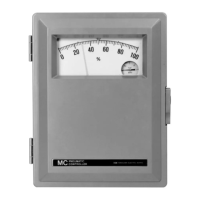<Appendix1.PressureElements>
A1-1
IM 02M04B01-01EN
Appendix1. PressureElements
A1.1 General
FA0101.ai
Spiral Helical Bellows
Common Pressure Measuring Elements
(1) Principle of Operation
A pressure movement consists of a measuring
element designed to expand or contract with
changes in internal pressure. The resulting
mechanical motion is transferred by a linkage to a
pointer. These measuring elements are operated
by pressures either above or below atmospheric;
therefore they can be used to measure vacuum as
well as positive pressure. Also, compound ranges
of both pressure and vacuum can be measured.
The pressure at any point below the surface of a
liquid is a measure of the height of liquid above that
point. Therefore, pressure instruments can also be
calibrated to read directly in terms of liquid level.
(2) PipingDetails
(seePageA1-2forpipingarrangements)
1. All piping to be 1/4-inch pipe or 3/8-inch tubing
of material and wall thickness to suit the
application.
2. When installing piping, external connections
on the instrument can be identied by tracking
each connection to its element and referring to
the nameplate on the element.
3. With gas or steam applications, connections at
the pipe or vessel are to be made on the top or
side. With liquid applications, connections are
to be made on the side only. Pitch all horizontal
lines for drainage or venting.
4. If the uid being measured has excessive
pressure uctuations or pulsations, a uid
damper should be installed. If the uid is
corrosive, viscous, or has solids in suspension,
a pressure seal or purge should be used.
5. Pressure elements must never be subjected to
pressures above their range unless they have
overrange protection.
IMPORTANT
If the instrument is zeroed at the level of the
vessel or line (as described on Page A1-2),
no correction is required. If the instrument is
checked against a test gauge at the level of the
instrument, the elevation correction must be
made.
(3) ElevationCorrection(liquid-lledsystems
only)
FA0102.ai
Elevation correction =
hight (m)
x specific gravity.
10
Instrument above lineInstrument below line
Test gauge
Test gauge
Negative pressure
of liquid column
Instrument reads low; adjust the
pointer upward with Zero
adjustment.
Instrument reads high; adjust the
pointer downward with Zero
adjustment.
Pressure of
liquid column

